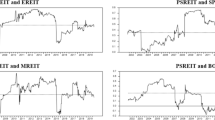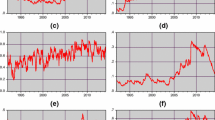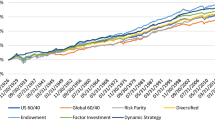Abstract
In this article we discuss whether commodities should be included as an asset class when establishing portfolios. By investigating second order stochastic dominance relations, we find that the stock and bond indices tend to dominate the individual commodities. We further study if we can find a combination of stocks, bonds and commodities that dominate others. Compared to a 60% stock and 40% bond portfolio mix, portfolios consisting of long positions in gold futures and two different actively managed indices are the only commodity investments to be included as long positions in a stock/bond portfolio. The results should be of interest for fund managers and traders that seek to improve their risk-return trade off compared to the traditional 60/40 portfolio.




Similar content being viewed by others
Notes
The returns are calculated as the natural logarithm of relative price differences.
For robustness check, we have compared our data from datastream with data from quandl.com and find similar developments of the futures series. The data set should therefore provide reliable results.
For more information on CYD and SDCI see https://www.vescore.com/en-int/what-we-offer/ and https://summerhavenindex.com/sdci/.
There are several different rolling techniques one can apply on futures contracts. Thomson Reuters Datastream provides six different (from Type 0 to Type 5).
Test for difference in returns yield a t-statistic of 1.1, and the F-test for differences in variance exhibit a F-value of 1.17 with a F-critical of 1.22.
References
Ambachtsheer, K. P. (1987). Pension fund asset allocation: In defense of a 60/40 equity/debt asset mix. Financial Analysts Journal, 43(5), 14–24.
Belousova, J., & Dorfleitner, G. (2012). On the diversification benefits of commodities from the perspective of euro investors. Journal of Banking & Finance, 36(9), 2455–2472.
Bessler, W., & Wolff, D. (2015). Do commodities add value in multi-asset portfolios? An out-of-sample analysis for different investment strategies. Journal of Banking & Finance, 60, 1–20. https://doi.org/10.1016/j.jbankfin.2015.06.021. ISSN 0378-4266.
Bhardwaj, G., Gorton, G., & Rouwenhorst, G. (2015). Facts and fantasies about commodity futures ten years later. Technical report, The National Bureau of Economic Research, June 2015. https://doi.org/10.3386/w21243.
Brooks, C., & Prokopczuk, M. (2013). The dynamics of commodity prices. Quantitative Finance, 13(4), 527–542. https://doi.org/10.1080/14697688.2013.769689.
Cao, B., Jayasuriya, S., & Shambora, W. (2010). Holding a commodity futures index fund in a globally diversified portfolio: A placebo effect. Economics Bulletin, 30(3), 1842–1851.
Chaves, D., Hsu, J., Li, F., & Shakernia, O. (2011). Risk parity portfolio vs. other asset allocation heuristic portfolios. The Journal of Investing, 20(1), 108–118.
Cheng, I.-H., & Xiong, W. (2014). Financialization of commodity markets. Annual Review of Financial Economics, 6(1), 419–441.
Commodity Futures Trading Commission. (2008). Staff report on commodity swap dealers & index traders with commission recommendations. Technical Report, CFTC, September 2008.
Daigler, R. T., Dupoyet, B., & You, L. (2017). Spicing up a portfolio with commodity futures: Still a good recipe? The Journal of Alternative Investments, 19(4), 8–23.
Daskalaki, C., & Skiadopoulos, G. (2011). Should investors include commodities in their portfolios after all? New evidence. Journal of Banking & Finance, 35(10), 2606–2626. https://doi.org/10.1016/j.jbankfin.2011.02.022.
Daskalaki, C., Skiadopoulos, G., & Topaloglou, N. (2017). Diversification benefits of commodities: A stochastic dominance efficiency approach. Journal of Empirical Finance, 44, 250–269.
Demirer, R., Lee, H.-T., & Lien, D. (2015). Does the stock market drive herd behavior in commodity futures markets? International Review of Financial Analysis, 39, 32–44.
Dentcheva, D., & Ruszczyński, A. (2003). Optimization with stochastic dominance constraints. SIAM Journal on Optimization, 14(2), 548–566. https://doi.org/10.1137/S1052623402420528.
Dentcheva, D., & Ruszczyński, A. (2006). Portfolio optimization with stochastic dominance constraints. Journal of Banking & Finance, 30, 433–451. https://doi.org/10.1016/j.jbankfin.2005.04.024.
Dentcheva, D., & Ruszczyński, A. (2011). Portfolio optimization with risk control by stochastic dominance constraints. In: Infanger, G. (ed), Stochastic programming, volume 150 of international series in operations research & management science, Chapter 9 (pp. 189–211). Springer Science+Business Media, LLC, https://doi.org/10.1007/978-1-4419-1642-6.
Doeswijk, R., Lam, T., & Swinkels, L. (2014). The global multi-asset market portfolio 1959–2012. Financial Analysts Journal, 70(2), 26–41.
Dwyer, A., Gardner, G., & Williams, T. et al. (2011). Global commodity markets-price volatility and financialisation. Reserve Bank of Australia Bulletin, June, pp. 49–57.
Erb, C. B., & Harvey, C. R. (2006). The strategic and tactical value of commodity futures. Financial Analysts Journal, 62(2), 69–97. https://doi.org/10.2469/faj.v62.n2.4084.
Erb, C. B., & Harvey, C. R. (2013). The golden dilemma. Financial Analysts Journal, 69(4), 10–42.
Faber, M. (2015). Global asset allocation: A survey of the world’s top asset allocation strategies. The Idea Farm, LP. ISBN:978-0-9886799-2-4.
Fábián, C. I., Mitra, G., & Roman, D. (2009). Processing second order stochastic dominance models using cutting plane representations. Mathematical Programming, 130(1), 33–37. https://doi.org/10.1007/s10107-009-0326-1.
Fabozzi, F . J., Fuss, R., & Kaiser, D . G. (2008). The handbook of commodity investing (pp. 156). Wiley.
Föllmer, H., & Schied, A. (2004) Stochastic finance: An introduction in discrete time. In: de Gruyter studies in mathematics, vol. 27. Berlin, Boston: De Gruyter. http://books.google.com/books?id=cL-bZSOrqWoC.
Geman, H. (2009). Commodities and commodity derivatives: Modeling and pricing for agriculturals, metals and energy. Wiley. ISBN 978-0-470-01218-5.
Gorton, G., & Rouwenhorst, K. G. (2006). Facts and fantasies about commodity futures. Financial Analysts Journal, 62(2), 47–68. https://doi.org/10.2469/faj.v62.n2.4083.
Gutjahr, W. J., & Pichler, A. (2013). Stochastic multi-objective optimization: A survey on non-scalarizing methods. Annals of Operations Research, 236(2), 1–25. https://doi.org/10.1007/s10479-013-1369-5.
Hamilton, J. D., & Wu, J. C. (2015). Effects of index-fund investing on commodity futures prices. International Economic Review, 56(1), 187–205.
Henderson, B. J., Pearson, N. D., & Wang, L. (2014). New evidence on the financialization of commodity markets. Review of Financial Studies, 28, 1285–1311.
Idzorek, T. M., Till, H., & Eagleeye, J. (2007). Commodities and strategic asset allocation. In Intelligent commodity investing, risk books. pp. 113–177.
Irwin, S. H., & Sanders, D. R. (2012). Financialization and structural change in commodity futures markets. Journal of Agricultural and Applied Economics, 44(03), 371–396.
Jensen, G. R., Johnson, R. R., & Mercer, J. M. (2000). Efficient use of commodity futures in diversified portfolios. Journal of Futures Markets, 20(5), 489–506.
Kat, H. M., & Oomen, R. C. (2007a). What every investor should know about commodities, Part I: Multivariate return analysis. Journal of Investment Management, 5(1), 4–28.
Kat, H. M., & Oomen, R. C. (2007b). What every investor should know about commodities, Part II: Multivariate return analysis. Journal of Investment Management, 5(1), 40–64.
Keating, C., & Shadwick, W. F. (2002). A universal performance measure. Journal of Performance Measurement, 6(3), 59–84.
Laws, J., & Thompson, J. (2007). Portfolio diversification and commodity futures. Unpublished paper, CIBEF. Liverpool: Liverpool John Moores University.
Lombardi, M. J., & Ravazzolo, F. (2016). On the correlation between commodity and equity returns: Implications for portfolio allocation. Journal of Commodity Markets, 2(1), 45–57.
Masters, M. W. (2009a). Testimony of Michael W. Masters. Committee on Agriculture, Nutrition and Forestry, (June 4), pp. 1–29.
Masters, Michael W. (2009b). Testimony of Michael W. Masters. Commodities Futures Trading Commission, (Aug 5), pp. 1–21.
Meyer, G. (2015, Sept 15). Commodity index investing debate reignites. Financial Times, https://www.ft.com/content/9b307c8c-5d69-11e5-9846-de406ccb37f2.
Miffre, J. (2014). Comparing first, second and third generation commodity indices. Alternative Investment Analyst Review, 3(2), 22–33.
Miffre, J. (2016). Long-short commodity investing: A review of the literature. Journal of Commodity Markets, 1(1), 3–13.
Müller, A., & Stoyan, D. (2002). Comparison methods for stochastic models and risks. Wiley series in probability and statistics. Wiley, Chichester. https://books.google.com/books?id=a8uPRWteCeUC. ISBN 978-0-471-49446-1
Ogryczak, W., & Ruszczyński, A. (1999). From stochastic dominance to mean-risk models: Semideviations as risk measures. European Journal of Operational Research, 116, 33–50. https://doi.org/10.1016/S0377-2217(98)00167-2.
Ogryczak, W., & Ruszczyński, A. (2002). Dual stochastic dominance and related mean-risk models. SIAM Journal on Optimization, 13(1), 60–78. https://doi.org/10.1137/S1052623400375075.
Pflug, G. Ch., & Römisch, W. (2007). Modeling, measuring and managing risk. River Edge, NJ: World Scientific. https://doi.org/10.1142/9789812708724.
Pflug, G. Ch., Pichler, A., & Wozabal, D. (2012). The 1/ N investment strategy is optimal under high model ambiguity. Journal of Banking & Finance, 36(2), 410–417. https://doi.org/10.1016/j.jbankfin.2011.07.018.
Pichler, A. (2017). A quantitative comparison of risk measures. Annals of Operations Research, 254(1), 251–275. https://doi.org/10.1007/s10479-017-2397-3.
Qian, E. (2011). Risk parity and diversification. Journal of Investing, 20(1), 119.
Roncalli, T. (2013). Introduction to risk parity and budgeting. Cambridge: CRC Press.
Roncoroni, A., Fusai, G., & Cummins, M. (2015). Handbook of multi-commodity markets and products: Structuring, trading and risk management. Wiley. https://doi.org/10.1002/9781119011590.
Sanders, D. R., & Irwin, S. H. (2011). The impact of index funds in commodity futures markets: A systems approach. The Journal of Alternative Investments, 14(1), 40–49. https://doi.org/10.3905/jai.2011.14.1.040.
Sanders, D. R., & Irwin, S. H. (2012). A reappraisal of investing in commodity futures markets. Applied Economic Perspectives and Policy, 34(3), 515–530. https://doi.org/10.1093/aepp/pps026.
Scaillet, O., & Topaloglou, N. (2010). Testing for stochastic dominance efficiency. Journal of Business & Economic Statistics, 28(1), 169–180.
Sharpe, W. F. (1994). The Sharpe ratio. The Journal of Portfolio Management, 21(1), 49–58. https://doi.org/10.3905/jpm.1994.40950.
Silvennoinen, A., & Thorp, S. (2013). Financialization, crisis and commodity correlation dynamics. Journal of International Financial Markets, Institutions and Money, 24, 42–65. https://doi.org/10.1016/j.intfin.2012.11.007.
Steen, M., & Gjolberg, O. (2013). Are commodity markets characterized by herd behaviour? Applied Financial Economics, 23(1), 79–90. https://doi.org/10.1080/09603107.2012.707770.
Stoll, H. R., & Whaley, R. E. (2011). Commodity index investing: Speculation or diversification? The Journal of Alternative Investments, 14(1), 50–60. https://doi.org/10.2139/ssrn.1633908.
Tang, K., & Xiong, W. (2012). Index investment and the financialization of commodities. Financial Analysts Journal, 68(5), 54–74.
You, L., & Daigler, R. T. (2013). A Markowitz optimization of commodity futures portfolios. Journal of Futures Markets, 33(4), 343–368. https://doi.org/10.1002/fut.21553.
Acknowledgements
We would like to thank the editor of the journal and the referees for their commitment to assess and improve the paper. We would also thank the discussants at ECOMFIN2016 in Paris.
Author information
Authors and Affiliations
Corresponding author
Rights and permissions
About this article
Cite this article
Henriksen, T.E.S., Pichler, A., Westgaard, S. et al. Can commodities dominate stock and bond portfolios?. Ann Oper Res 282, 155–177 (2019). https://doi.org/10.1007/s10479-018-2996-7
Published:
Issue Date:
DOI: https://doi.org/10.1007/s10479-018-2996-7




